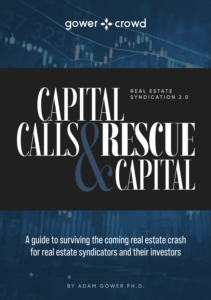Value Over Volume: Building Real Estate Investor Network on Social Media
By Adam Gower Ph.D.
Real estate investment isn’t as eye-catching and sexy as food and travel, but it’s a topic some people on Instagram care about. Find them and help them find you. With social media, the quality of your followers matters a lot more than the quantity.
Stop thinking of Instagram, Facebook, Twitter, or any other social networking platform as purely a numbers game. Consider it from a more practical standpoint. Social media is about relevance rather that popularity.
What’s the Magic Number?
In the beginning, success on social media was defined by how many followers you had. Someone with 1 million followers was considered a bigger success than another person in the same niche with only 1,000 followers. Today, the rules of success have changed.
The number of followers you have is more superficial than anything else. It can be an important marker of success, but only when it’s considered alongside a few other numbers. Namely: engagement stats, conversion rate, and cost per conversion.
Engagement stats include the like to dislike ratio, ratio of interactions compared to total views, views compared to total followers, and the number of comments. These are the general engagement stats that matter most in calculating how engaged your follower base actually is. Low engagement means a high follower count may not actually matter in terms of accomplishing your goals.
Get access to our FREE weekly newsletter exclusively covering the latest updates from the real estate crowdfunding world
Conversion rate and cost per conversion are two related numbers that help answer the question of how you’re doing at monetizing your investor base. Who cares that you have 100k followers if your average conversion rate from social media is only 0.01%? That would mean that only 1 out of every 10k views equals a conversion. If you’re dealing with high-value investments, maybe that ratio is okay. But, if you’re working with lower budget crowdfunded investments, that’s not a great number.
Cost per conversion is exactly what it sounds like. If you average out the cost of creating content and managing your social media account, how does that compare with the number of conversions you’re getting?
Are you spending more or less on conversions from other sources? This is a good marker about whether your current strategy is really helping or hurting in the long run.
Social Media Is Just People
Imagine social networking platforms as very large rooms full of potential investors. There are all kinds of prospects in the room from all different demographics and walks of life. Many have varying interests, passions, hobbies, or priorities. Would you walk up to a random person in that room and start immediately trying to sell your project? Absolutely not!
Treat social media platforms like networking events. You need to have a conversation and get to know someone a bit more before you bring up anything about what you’re offering. Get personal, chat with people, form relationships, and create strong connections. This is how you end up monetizing your followers and forming valuable relationships.
Every social media platform is some variation on a room full of people. You’ll get the chance to interact with so many new people, way more than you’d meet at a typical networking event, so you need to make the exchange worth it for both of you.
Apply the same principles as you would at any networking event to find, build, and strengthen connections with your ideal investors.
The Right People, Not the Right Number
As much as we love numbers and data, social media isn’t all about the numbers. If you have a highly engaged following of 1,000 people that are passionate about investing, have invested or are interested in investing with your company, and who have a right chance of converting or connecting you to people who will convert, you’ve nailed it.
A handful of engaged, converting, passionate followers is infinitely better than a mass following of vaguely interested, mostly disengaged people who are unlikely to convert or refer people who will convert. Connecting with the right people is vastly more important than connecting with the most people.
If you were to go to a networking event, how many valuable potential leads, investors, or connections would you have to make for it to be worth your time? Consider your social media accounts with the same scrutiny.
It’s not about how many people you meet, it’s about how many valuable connections you’re making with your time.
Get access to our FREE weekly newsletter exclusively covering the latest updates from the real estate crowdfunding world
Selling to Your Audience
When your followers are people who are just as passionate about real estate and investment as you are, it will be far easier to sell to them over time. Focus on relationship building and connections, giving great value to your followers all along the way. Don’t push the sales side of it on a regular basis, or you’re likely to turn off some potential leads.
If you’re too sale-focused from the beginning, it will come out in your content. Don’t use every post to advertise and sell. That’s a recipe for disengagement! Provide value upfront so that on the occasions you do aim for some type of conversion (sales, email list signups, etc.), people will be far more receptive. You have already proved your value to them at that point and they’ll be more likely to trust that what you’re offering will be valuable to them.
"An audience of people who trust in the value you provide is better than an audience of unknown people."
Being successful on social media isn’t about how many followers you amass. The real marker of success is how valuable that base of followers turns out to be for your capital raising efforts.
If you have only just started in real estate development, have completed no deals, have no email list, but know you want the freedom and wealth being a real estate developer brings, then I suggest your first step is to start evaluating deals so you can recognize a good one when you see it.
Here’s where you should start. You’ll learn everything you need to know – the different types of real estate, different development strategies, how real estate cycles influence the market, and all about due diligence.
If you want to find deals and raise money for them so you can start your real estate development business, then learning how to conduct due diligence so you can pitch your deals better to investors is a great place to start.
If you’ve already purchased one or more real estate project and are seeing more opportunities than you can finance, then now is the time to start building your investor network so you can finance all your next deals quicker.
You’ve already got some momentum; now start finding and educating prospects about what you’re doing so you can build an email list of people to pitch to when you’re ready to raise money for your next deal.
This is what we build for private clients all the time – it’s called the Investor Acquisition System and you can access the entire program right here so you can find prospects, and convert them into being deep pocketed, repeat investors in your deals.
If you are a seasoned pro with multi-cycle experience, a substantial portfolio, a decent deal pipeline, and find yourself spending too much time raising equity capital because you’re still doing it in-person, then it’s time you put technology to work for you.
The wonderful thing about doing this is that you’re not going to be doing anything different than you’re already doing and, guess what, you’ll never have to sit through investor meetings again.
Sounds crazy I know, but I lay the whole thing out for you in this white board workshop where I personally show you exactly what it takes for you to transform your equity raising into a fully automated, capital raising machine so you can find new investors while increasing commitments from your existing network.






